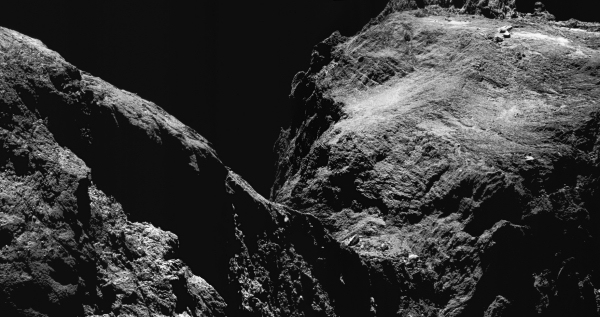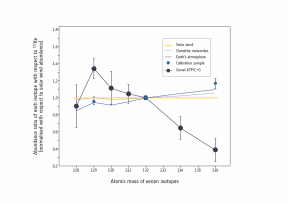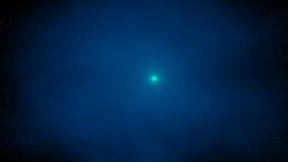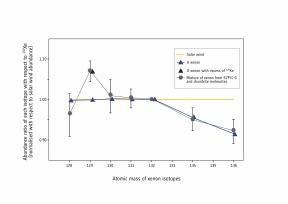Rosetta finds comet connection to Earth's atmosphere
8 June 2017
The challenging detection, by ESA's Rosetta mission, of several isotopes of the noble gas xenon at Comet 67P/Churyumov-Gerasimenko has established the first quantitative link between comets and the atmosphere of Earth. The blend of xenon found at the comet closely resembles U-xenon, the primordial mixture that scientists believe was brought to Earth during the early stages of Solar System formation. These measurements suggest that comets contributed about one fifth the amount of xenon in Earth's ancient atmosphere. |
| Comet 67P/Churyumov-Gerasimenko on 15 May 2016. Credit: ESA/Rosetta/NAVCAM – CC BY-SA IGO 3.0 |
Xenon – a colourless, odourless gas which makes up less than one billionth of the volume of Earth's atmosphere – might hold the key to answer a long-standing question about comets: did they contribute to the delivery of material to our planet when the Solar System was taking shape, some 4.6 billion years ago? And if so, by how much?
The noble gas xenon is formed in a variety of stellar processes, from the late phases of low- and intermediate-mass stars to supernova explosions and even neutron star mergers. Each of these phenomena gives rise to different isotopes of the element [1]. As a noble gas, xenon does not interact with other chemical species, and is therefore an important tracer of the material from which the Sun and planets originated, which in turns derives from earlier generations of stars.
"Xenon is the heaviest stable noble gas and perhaps the most important because of its many isotopes that originate in different stellar processes: each one provides an additional piece of information about our cosmic origins," says Bernard Marty from CRPG-CNRS and Université de Lorraine, France. Bernard is the lead author of a paper reporting Rosetta's discovery of xenon at Comet 67P/C-G, which is published today in Science [2].
 |
| Xenon across the Solar System. Credit: Data from B. Marty et al., 2017 and references therein |
It is because of this special 'fingerprint' that scientists have been using xenon to investigate the composition of the early Solar System, which provides important clues to constrain its formation. Over the past decades, they sampled the relative abundances of its various isotopes at different locations: in the atmosphere of Earth and Mars, in meteorites deriving from asteroids, at Jupiter, and in the solar wind – the flow of charged particles streaming from the Sun.
The blend of xenon present in the atmosphere of our planet contains a higher abundance of heavier isotopes with respect to the lighter ones; however, this is a result of lighter elements escaping more easily from Earth's gravitational pull and being lost to space in greater amounts. By correcting the atmospheric composition of xenon for this runaway effect, scientists in the 1970s calculated the composition of the primordial mixture of this noble gas, known as U-xenon, that was once present on Earth.
This U-xenon contained a similar mix of light isotopes to that of asteroids and the solar wind, but included significantly smaller amounts of the heavier isotopes.
"For these reasons, we have long suspected that xenon in the early atmosphere of Earth could have a different origin from the average blend of this noble gas found in the Solar System," says Bernard.
One of the explanations is that Solar System xenon derives directly from the protosolar cloud, a mass of gas and dust that gave rise to the Sun and planets, while the xenon found in the Earth's atmosphere was delivered at a later stage by comets, which in turn might have formed from a different mix of material.
 |
| Artist's impression of the protosolar cloud. Credit: ESA – CC BY-SA 3.0 IGO |
With ESA's Rosetta mission visiting Comet 67P/Churyumov-Gerasimenko, an icy fossil of the early Solar System, scientists could finally gather the long-sought data to test this hypothesis.
"Searching for xenon at the comet was one of the most crucial and challenging measurements we performed with Rosetta," says Kathrin Altwegg from the University of Bern, Switzerland, principal investigator of ROSINA, the Rosetta Orbiter Spectrometer for Ion and Neutral Analysis, which was used for this study.
Xenon is very diffuse in the comet's thin atmosphere, so the navigation team had to fly Rosetta very close – 5 km to 8 km from the surface of the nucleus – for a period of three weeks so that ROSINA could obtain a significant detection of all the relevant isotopes.
Flying so close to the comet was extremely challenging because of the large amount of dust that was lifting off the surface at the time, which could confuse the star trackers that were used to orient the spacecraft.
Eventually, the Rosetta team decided to perform this operation in the second half of May 2016. This period was chosen as a compromise so that enough time would have passed after the comet's perihelion, in August 2015, for the dust activity to be less intense, but not too much for the atmosphere to be excessively thin and the presence of xenon hard to detect.
As a result of the observations, ROSINA identified seven isotopes of xenon, as well as several isotopes of another noble gas, krypton; these brought to three the inventory of noble gases found at Rosetta's comet, following the discovery of argon from measurements performed in late 2014.
"These measurements required a long stretch of dedicated time solely for ROSINA, and it would have been very disappointing if we hadn't detected xenon at Comet 67P/C-G, so I'm really glad that we succeeded in detecting so many isotopes," adds Kathrin.
Further analysis of the data revealed that the blend of xenon at Comet 67P/C-G, which contains larger amounts of light isotopes than heavy ones, is quite different from the average mixture found in the Solar System. A comparison with the on-board calibration sample confirmed that the xenon detected at the comet is also different from the current mix in the Earth's atmosphere.
 |
| A link between xenon at Rosetta's comet and on Earth. Credit: Data from B. Marty et al., 2017 and references therein |
By contrast, the composition of xenon detected at the comet seems to be closer to the composition that scientists think was present in the early atmosphere of Earth.
"This is a very exciting result because it is the first discovery of a candidate for the hypothesised U-xenon," explains Bernard.
"There are some discrepancies between the two compositions, which indicate that the primordial xenon delivered to our planet could derive from a combination of impacting comets and asteroids."
In particular, Bernard and his colleagues were able to establish the first quantitative link between comets and our planet's gaseous shroud: based on the Rosetta measurements at Comet 67P/C-G, 22 percent of the xenon once present in Earth's atmosphere could originate from comets – the rest being delivered by asteroids.
This result is not in contradiction with the isotopic measurements of water at Rosetta's comet, which were significantly different to that found on Earth. In fact, given the trace amounts of xenon in Earth's atmosphere and the much larger amount of water in the oceans, comets could have contributed to atmospheric xenon without having a significant impact on the composition of water in the oceans.
The contribution inferred from the xenon measurements, instead, agrees with the possibility that comets have been significant carriers of pre-biotic material – such as phosphorus and the amino acid glycine, which were also detected by Rosetta at the comet – that was crucial to the emergence of life on Earth.
Finally, the difference between the blend of xenon found at the comet – which was incorporated in the nucleus at the time of its formation – and the xenon observed across the Solar System indicates that the protosolar cloud from which the Sun, planets, and small bodies were born was a rather inhomogeneous place in terms of its chemical composition.
"This conclusion is in accord with previous measurements performed by Rosetta, including the unexpected detections of molecular oxygen (O2) and di-sulphur (S2), and the high deuterium-to-hydrogen ratio observed in the comet water," adds Kathrin.
Additional evidence for the inhomogeneous nature of the protosolar cloud came also from anther study based on ROSINA observations, published in May in Astronomy & Astrophysics, which revealed that the mixture of silicon isotopes seen at the comet is different from what is measured elsewhere in the Solar System.
"As we anticipated last year, now that mission operations are over, the teams can focus on the science," says Matt Taylor, Rosetta Project Scientist at ESA.
"The detailed analysis performed in this work, based on specially designed operations, addresses one of the mission's key scientific goals: to find quantitative clues linking back to the formation and early evolution of our planet and Solar System."
Notes
[1] The lightest isotopes of xenon (124Xe and 126Xe) are produced during supernova explosions; intermediate-mass isotopes (127Xe, 128Xe, 129Xe, 130Xe, 131Xe and 132Xe) are produced during the Asymptotic Giant Branch phase of evolved low- and intermediate-mass stars; the heaviest isotopes (134Xe and 136Xe) are produced during the merger of neutron stars.
[2] The discovery of xenon by Rosetta at Comet 67P/Churyumov-Gerasimenko was announced during a Royal Society meeting in London, UK, and on the ESA Rosetta blog in June 2016, shortly after the scientists had made the detection. This is the first peer-reviewed study based on those measurements.
For further information please contact:
Bernard Marty
CRPG-CNRS, Université de Lorraine
Vandoeuvre-les-Nancy Cedex, France
E-mail: bmarty![]() crpg.cnrs-nancy.fr
crpg.cnrs-nancy.fr
Phone : +33 383 59 42 22
Kathrin Altwegg
Universität Bern
Switzerland
E-mail: altwegg![]() space.unibe.ch
space.unibe.ch
Phone: +41 31 6314420
Matt Taylor
ESA Rosetta Project Scientist
Directorate of Science
European Space Agency
Email: mtaylor![]() cosmos.esa.int
cosmos.esa.int
Phone: +31 71 565 8009




